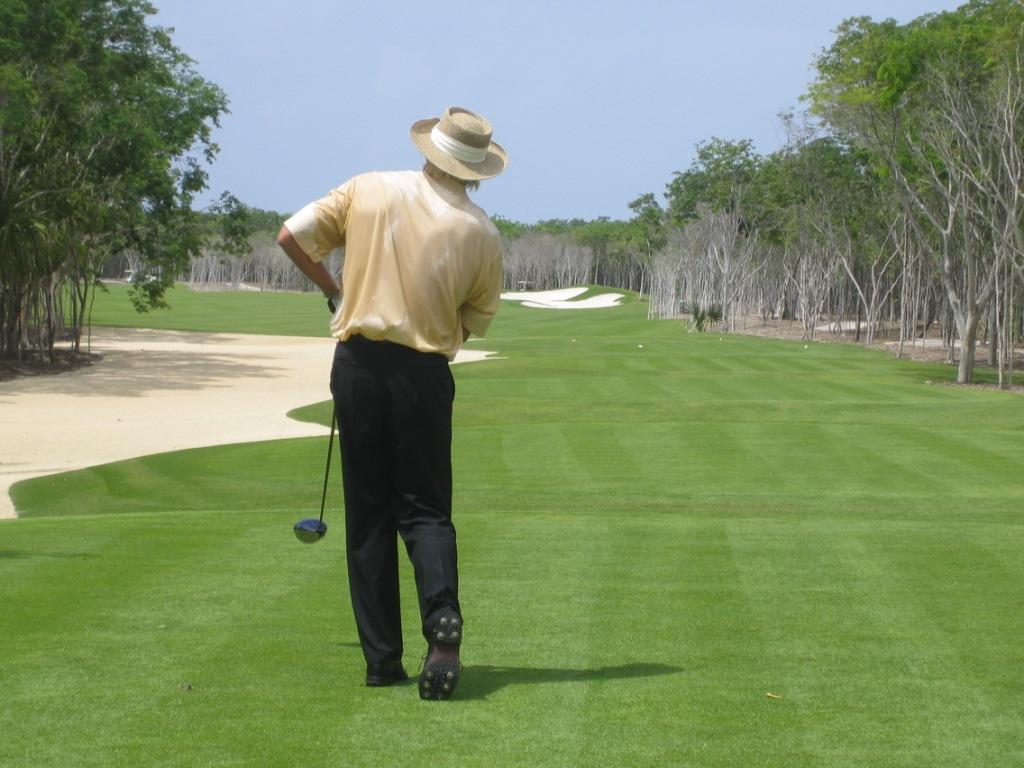
You never know what PGA Tour greats you might run into on the pro-am circuit. Greg Norman is the host of Mexico's only PGA Tour event, played on a course he designed, El Cameleon at Mayakoba, and here he hits a tee shot to show how it should be done.
Last post I explained why, if you can afford it, you should absolutely play in a pro-am at some point in your golf life. It’s just an incredibly fun experience. Now I am going to walk you through the experience so you are prepared.
The following is based on the typical PGA Tour pro-am, but will be similar for pro-ams on the Champions and LPGA Tours, while those on the Nationwide or other tours may be a little bit less ornate.
A handful of the flashier pro-ams, like the Verizon Heritage at Harbor Town on Hilton Head, have extra golf before the main event, but that is the exception, not rule. On the Champions Tour there are two full pro-ams most weeks because the events are only three days, not four, but in general, the pro-am day is always Wednesday, with the actual tournament starting Thursday, so for the most part, your pro-am experience kicks into high gear around cocktail hour on Tuesday, with the “Pairings Party.”
Typically held at the clubhouse or a nearby hotel, usually the official host where many Toru players stay, this is cocktails followed by a banquet style dinner. Sometimes it includes the check-in, and if not, is the second registration option for those how missed an earlier registration session. You will typically get credentials and maybe some swag, like a shirt and a dozen balls, thought most of the good stuff comes at the actual pro-am. You will probably get your tournament passes, parking pass and pro-am credential, usually a belt medallion like the tour pros use for tournament access, which you need to get in and makes a great souvenir/money clip. No matter how drunk you get at the party, do not lose these!
The main event is the player draft. Unfortunately, some pro-ams, like the one at Mayakoba, have gone to pre-selection process where the “pairings” simply means they announce who you are playing with. This makes things faster but cuts out the fun and drama.
The norm is this: each group of amateurs, 3 or 4 per pro depending on the event, is assigned a number. A big board on the stage shows all the available pros and their tee times, which typically are divided into two sessions, AM (7-9:30 or so) and PM (12-2:30 or so). They pull numbers out of a hat, and each team has something like 30 seconds or a minute to choose a pro, so usually your team will want to make a list of choices at least 10 or 15 players deep so you are ready. If your team does not have someone at the pairing party you will get the last kid picked! If you don’t get picked until late and all your players are gone you can scramble to readjust your wish list. Seeing amateurs, usually somewhat impaired by free booze, huddled over their sheets like the NFL draft, is an interesting sight!
There is a perception that the top players are impossible to get, but this is not true. Usually the main tournament sponsor will have 1-2 automatic picks, and if there is a secondary sponsor, they might have one as well, but that is usually it. When Tiger was sponsored by Buick, if he played at the Buick Open or Invitational, he’d be locked up and your chances would be nil. But at the Verizon for instance, Verizon gets only one pick, and it is the defending champion, so if Tiger is playing (he has) and he didn’t win last year, he is up for grabs, along with everyone else in the usually very strong field. However at this event they do it a bit differently, picking both a team of amateurs and a pro randomly and matching them so there is no drafting.
At the Canadian Open last year, Mike Weir and Anthony Kim were taken by sponsors, but everyone else, including John Daly and several other Major champs, were available. You can get current big name players – at the FBR in Scottsdale two yeas ago I got Geoff Oglivy, US Open Champion and then world Top 10, and you can often get big name players who are not currently doing that well, like when my team drafted Stuart Appleby in the Viking Classic last year. Many teams end up “settling” for journeyman players, but in my experience these have been the most fun to play with, and if you happen to get a pro who is an ass – and it happens all too often – you still have a great story afterwards.
So that’s how the pairings party works. Some teams just want big names, others care more about the tee time, others just want to have fun, but anything can happen and usually does. You leave the pairing party with your pro selection, your tee time, your credentials and a nice buzz on.
The Big Show is tomorrow!
